new initiation lot
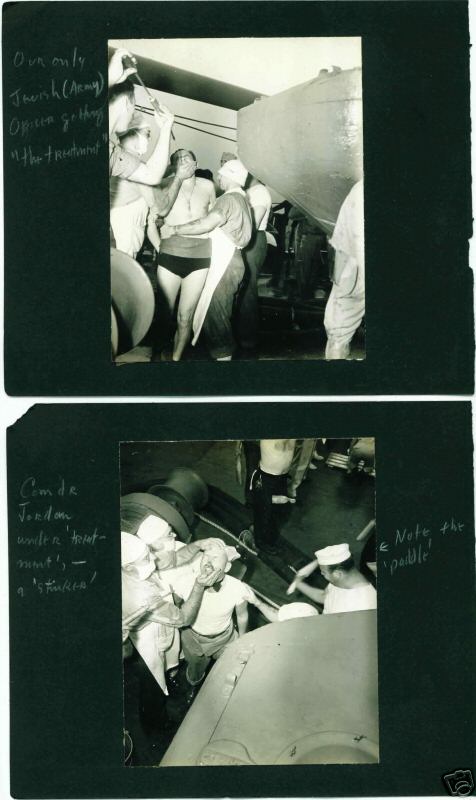
sellers text : This is one of my more unusual and poignant offerings. I contemplated selling these photos individually, but finally decided that it would be best to keep the collection together because most of them were part of the initiation on this ship. Should they sell, certainly, for some, they will bring back some fond shipboard memories during the World War II era. Please note that the picture of the Blue Ridge below with the photo scans is from an internet research reference, and is not offered as part of this auction.
OFFERED:
are 20 vintage photos taken in 1944 aboard the USS Blue Ridge (AGC-2), an amphibious force flagship of the United States Navy. Most of the photos show sailors engaging in comical antics of what is described on one of the album leaves as a “Shell-Back Initiation, Mid-Pacific – Blue Ridge, 1944.” The sailors all appear to be having a good time, save for suffering some indignity for those getting the “treatment. HMMM…I wonder if their Admiral knew of their antics. Many of the photos are identified and they are dry mounted on loose black album leaves (they can easily be removed from the leaves). Photos measure variously from 2 ¼” x 3 ¼” to 4 ½” x 3 ½”. Removed from the album leaves and creatively re-captioned, matted and framed, they would make a wonderfully historic and nostalgic montage for wall display. Certainly, for some, they will bring back fond memories of happier times during the World War II era.
Photos:
#1 Sailor in knee boots, gloves, and “Pirate’s”bandana; captioned: #1, Shell-Back Initiation, Mid-Pacific – Blue Ridge, 1944
#2 Sailor on knees among other sailors, being fed from a bottle; captioned: #2, S. B. Init., Baby, ‘Baby’ & ‘Buhle’
#3 Sailor with rubber gloves shaking hands with officer; no caption
#4 Sailor on knees among other sailors, being fed from a bottle; no caption
#5 Sailors on knees among other sailors being hosed with water; no caption
#6 Sailors being paddled among other sailors; no caption
#7 Sailors on knees being hosed with water among other sailors; no caption
#8 Sailors on knees being hosed with water in a chute and paddled among other sailors; no caption
#9 Sailor being held at waist and mouth among other sailors; captioned: Our only Jewish (Army) Officer getting “the treatment”
#10 Sailor being held by the head with two hands and paddled among other sailors; captioned: Comdr. Jordan under ‘treatment’,-a ‘stinker’, Note the ‘paddle’
#11 Sailor having head held with two hands while another sailor squirts something in his mouth; captioned: “The Doctor”
#12 Sailors having haircuts; captioned: “The Barber
#13 &14 Sailors with priest at Mass, and lone sailor; captioned: Mass, Blue Ridge, 1944, “Pete”
#15 & 16 Two sailors fishing on deck, and ship’s radar mast; captioned: J. C. C. Blue Ridge, and ?, B. R. (GC-2) McLaughlin & Main Radar Mast
#17 & 18 Lone sailor, arms crossed, and two sailors; captioned: Palmer, and Blue Ridge, Wilmer
#19 & 20 Two sailors, and stooping lone sailor; captioned: Peterson, and Wilmer
CONDITION:
Photos are nice with modest wear and patina, and the photo with the radar mast does have some spots; album leaves are loose with mostly minor edge tattering
QUESTIONS:
Please feel free to email me with any specific questions or comments.
BUYER INFORMATION:
I DO NOT USE PAYPAL.
Buyer pays U. S. shipping of $3.85 via USPS Priority Mail plus insurance.
Personal check or money order accepted in U. S.
Western Union BidPay or cash (U.S. and at buyer's risk) only on international shipment.
Canadian POSTAL money orders in U. S. dollars are also acceptable.
Rhode Islanders incur a 7% sales tax.
Ebay recommends contacting the seller within 3 days and payment within 10 days. Please respond to emails and send payment in a timely manner. You can be assured that I will promptly attend to your emails and delivery of purchase. IF YOU DO NOT RECEIVE MY EMAIL IN YOUR INBOX, PLEASE CHECK YOUR EMAIL FILTERS (“JUNK MAIL”), AS MY EMAILS MAY SOMETIMES GO THERE DUE TO THE LEADER IN MY EMAIL ADDRESS.
Thank you for your participation.
RESEARCH:
“History of USS Blue Ridge
USS Blue Ridge (LCC-19) was commissioned on November 14, 1970, at the Philadelphia Naval Shipyard as the most sophisticated command and control platform in the Navy. With accommodations for more than 200 officers and 1200 enlisted, the ship provides all the services of a small town.
From 1971 until 1979, Blue Ridge operated from San Diego, California, where she deployed to the Western Pacific, earning the Meritorious Unit and Navy Unit Commendations for the evacuation of Saigon, Vietnam in 1975.
Since October 1979, Blue Ridge has been forward deployed from Yokosuka, Japan as the flagship of Commander Seventh Fleet. Well suited to support a fleet commander in peacetime and in war, Blue Ridge participates routinely in U.S. and allied training exercise each year with countries throughout the Western Pacific and Indian Ocean. She performed brilliantly during a nine-and-one-half month deployment as flagship for Commander United States Naval Forces Central Command during Operations Desert Shield and Desert Storm from August 1990 through May 1991, for which the ship earned another Navy Unit Commendation.
USS Blue Ridge frequently makes port calls throughout the Western Pacific and Indian Ocean including Japan, Hong Kong, Singapore, Indonesia, Malaysia, Thailand, and Australia. She made her historic port visit to Shanghai, People Republic of China in May 1989 and Vladivostok, Russia in July 1996. The ship has also been cited for rescues of refugees and merchant vessels. USS Blue Ridge continuously upgrades her command and control facilities, her warfighting capabilities and her methods of meeting the high visibility requirements of a fleet flagship.
The first USS Blue Ridge (S. P. 2432) was originally constructed as the Great Lakes passenger steamer VIRGINIA built by Globe Iron Works at Cleveland, Ohio. The ship was launched in 1891 and was operated by the Goodrich Transit Company between Chicago, Illinois and Milwaukee, Wisconsin. In 1893, during the Chicago World's Fair, the ship and the whaleback steamer CHRISTOPHER COLUMBUS competed against each other in races. VIRGINIA was purchased on April 19, 1918 for use as a Navy transport at Manitowoc, Wisconsin once America entered World War I. The ship was renamed BLUE RIDGE (S. P. 2432) and commissioned on October 17, 1918. Lieutenant Commander E. S. Ells, USNR, was the commanding officer. The ship was named for the BLUE RIDGE Mountains of the United States. Blue Ridge (S. P. 2432) had an overall length of 269 feet, 2 inches; extreme beam of 38 feet, 3 inches; tonnage of 1,606; draft of 12 feet, 8 inches; speed of 16.5 knots; and a crew of 87officers and enlisted.
On December 28, 1918, the ship arrived at the Boston Navy Yard from the Great Lakes. While undergoing repairs, the war ended and eliminated the need for further service. While still at the Navy Yard, the ship's name was changed to Avalon on August 18, 1919. The Edward P. Farley Company, from Chicago bought the ship on August 21, 1919. The Wilmington Transportation Company acquired Avalon. In 1920, the ship entered the company's two-hour daytime run between the Catalina Island Terminal at Wilmington and Los Angeles harbor. During World War II, Avalon served as a transport in the San Francisco Bay area. The ship returned to the Catalina-Los Angeles run in 1946 and remained in this service until laid up at the Catalina Island Terminal February 12, 1951. Avalon caught fire and burned at Long Beach, California on July 18, 1960.
The next Blue Ridge (AGC-2), an amphibious force flagship, was built by the Federal Shipbuilding and Dry Dock Company, Kearny, New Jersey, under a Maritime Commission contract. The ship was launched on March 7, 1943 under the sponsorship of Mrs. David Arnott. Blue Ridge was transferred to the Navy on March 15, 1943. The Bethlehem Steel Company of Brooklyn, New York, outfitted the ship as an amphibious force flagship and was commissioned on September 27, 1943. Commander Lewis R. McDowell, USN, was the commanding officer.
Blue Ridge (AGC-2), had an overall length of 459 feet, 3 inches; extreme beam of 63 feet; trial displacement of 13, 910 tons; limiting draft of 24 feet; trial speed of 16.6 knots; a complement of 36 officers and 442 enlisted; and a flag accommodations for 138 officers and 123 enlisted. The ship was armed with two 5-inch .38 caliber guns and four twin 40-mm anti-aircraft guns. Following trial runs in Long Island Sound, Blue Ridge departed New York on October 8, 1943, to train in the Chesapeake Bay Area out of Norfolk, Virginia. On November 1, the ship put to sea with two destroyers, bound for the South Pacific. After transit of the Panama Canal, BLUE RIDGE called at the Society, New Caledonia and Fiji Islands, enroute to Brisbane, Australia, arriving on December 16, 1943. She pulled out of Brisbane three days later for Milne Bay, New Guinea where December 24, 1943, she became the flagship of Rear Admiral Daniel E. Barbey, USN, Commander Seventh Amphibious Force. She served as the command ship for amphibious operations westward along the New Guinea Coast until October 13, 1944. On that day, BLUE RIDGE left Hollandia as the flagship of Rear Admiral Barbey's Northern Attack Force bound for the liberation of the Philippine Islands.
The night of October 19-20, 1944 Blue Ridge and her formation stood through the swept part of Surigao strait, between Homonhon and Dinagat Islands and entered San Pedro Bay, Leyte, Philippine Islands. She served as a command ship for troops storming the beaches at Leyte the morning of October 20, and continued in support of the amphibious assault landings for six days. The ship's gunners drove off an enemy reconnaissance plan October 23. The morning of October 25, a torpedo-bomber made a run along her port side, coming in from her port quarter, and was shot down by her forward 40-mm gunners. That afternoon, the ship fired on 11 enemy planes of various types attacking the transport area.
The morning of October 26, 1944, Blue Ridge helped fight off five enemy bombers that attacked her formation. That afternoon she helped drive away three more enemy bombers. Several bombs fell in the vicinity during this action, but only one exploded close enough to shake the command ship. As she kept watch off the Leyte beaches, the three-pronged attack of the Japanese Fleet met disaster in the Battle of Surgiao Strait, the Battle of Samar and the Battle of Cape Engano. She stood out of San Pedro Bay in the night of October 26, 1944 to stage at ports of New Guinea in preparation for the liberation landings to be made at Lingayen. She remained the flagship of Vice Admiral Barbey who was designated commander of the San Fabian Attack Force 78. Besides Admiral Barbey and his staff, she embarked Major General I. P. Swift, commanding the I Army Corps, and Major General L. F. Wing, Commanding the 43rd Infantry Division, together with their personal staffs.
Blue Ridge led the San Fabian Attack Force from Aitape, New Guinea on December 28, 1944. An aerial snooper was driven off by gunfire January 2, 1945 and covering escort carrier aircraft shot down a bomber twenty miles out from her formation the following day. The night of January 4, 1945 the command ship followed a covering group of cruisers and destroyers through Surigao Strait to enter the Mindanao Sea. The afternoon of January 5 an enemy submarine fired on the covering group, ten miles ahead, and was forced to surface and rammed by destroyer Dashiell. Enemy planes attacked the formation January 7; two being shot down by pilots of the Combat Air Patrol, and three fell victims to combined anti-aircraft fire of the formation. That night four destroyers sank a Japanese destroyer eleven miles to the east of Blue Ridge. The command ship helped repel six enemy planes on January 8, 1945 and entered Linguine Gulf before daybreak of January 9. Troops stormed ashore that morning, some two hours after a single-engine enemy aircraft sneaked through cover of night, staffed to a point forward of the bow, barely missed the bridge, then overshot and dropped bombs about 500 yards off her port bow. The ship was not damaged and suffered no casualties. During the initial landings, three air attacks came close enough to be a threat to Blue Ridge, but veered off the in the face of heavy anti-suicide swimmers and small fast suicide boats. To combat this threat, a patrol boat was kept circling Blue Ridge and all shipboard security patrols were strengthened.
On January 13, 1945 Chief Storekeeper H. G. Williamson reported on board Blue Ridge. He was an escaped prisoner of war, having been captured by the Japanese on January 18, 1942, while attached to the Naval Air Station at Cavite. He had escaped on March 15, 1942 and had remained in hiding near San Fabian since then. Williamson was returned to duty at the Naval Base and Blue Ridge departed Lingayen Gulf on January 15, 1945. The ship continued to serve as Vice Admiral Barbey's flagship at San Pedro Bay and Subic Bay until June 8, 1945. Two days later, Blue Ridge was underway for Saipan and then to Pearl Harbor when she became the flagship of Rear Admiral Jerauld Wright, Commander Amphibious Group Five on June 30, 1945. She hauled down his flag on July 20 and entered the Pearl Harbor Naval Shipyard for alterations and repairs.
USS Blue Ridge departed Pearl Harbor on September 8, 1945 and reached Buckner Bay, Okinawa, on September 22. That afternoon, she hoisted the flag of Rear Admiral Ingolf N. Kiland, Commander Amphibious Group Seven. The ship got underway on October 21 to serve as a command ship at Tsingtao, China, arriving October 24, 1945. Rear Admiral Kiland shifted his flag to WASTACH (AGC-9) on November 6, 1945 and BLUE RIDGE became the flagship of Rear Admiral A. G. Noble, Commander Amphibious Group One.
The ship departed Tsingtao for Jinsen, Korea on December 13, 1945, then returned off Taku Bar before proceeding to Shanghai, China. She arrived in the Wonsung Anchorage of the Uangtze River on December 22, 1945, and served as station command ship for Naval Forces there until February 24, 1946, when the ship departed Shanghai for Hawaii. After a brief stay at Pearl Harbor, she was routed to the western seaboard, arriving at San Pedro, California on March 18, 1946. The ship entered the Naval Shipyard at Terminal Island to prepare for participation in "Operation Crossroads", the atomic bomb tests to be carried out at Bikini Atoll, Marshall Islands.
Blue Ridge departed San Francisco on June 12, 1946, touching at Honolulu, Hawaii, enroute to Kwajalein Atool where she arrived June 28, 1946. Here the ship completed embarking general and flag officers of the Army, Navy and Marine Corps along with United Nations officials for transportation to Bikini Atoll to observe Atomic Bomb Tests. She hoisted the flag of Vice Admiral H. W. Hill. The senior officer on board was Vice Admiral E. L. Cochrane, Chief of the Bureau of Ships. Also on board were Vice Admiral G. F. Hussey and Vice Admiral A. E. Montgomery.
The ship arrived at Bikini Atoll on June 29, 1946, serving as one of the command and observation ships off Bikini during the Atomic Bomb Test "Able" on July 1. Thereafter, she called at Ponape and Truk in the Caroline Islands, then proceeded to Kwajalein where, on July 23rd, Blue Ridge became the flagship of Rear Admiral C. C. Glover. The ship again served as observation flagship for the atomic bomb test of July 24, hauled down Rear Admiral Glover's flag on July 27, and sailed for home on July 30. She arrived at San Francisco inactivation overhaul in the Naval Shipyard at Terminal Island; she decommissioned on March 14, 1947. The ship remained in reserve until January 1, 1960, when her name was struck from the Navy list. She was sold for scrapping August 26, 1960 to Zidell Exploration Incorporated, 3121 Southwest Woody Street, Portland, Oregon.
USS Blue Ridge (AGC-2) received two battle stars and other awards for the operations listed below:
One Star/LEYTE OEPRATION: Leyte Landings: October 13-30, 1944
One Star/LUZON OPERATION: Lingayen Gulf Landings: January 9-14, 1945
NAVY OCCUPATION SERVICE MEDAL (Asia Clasp): September 22, 1945-
February 24, 1946
CHINA SERVICE MEDAL: September 22, 1945-February 24, 1946
REPUBLIC OF THE PHILIPPINES PRESIDENTIAL UNIT CITATION BADGE” i won this lot tonight for an uncontested $50.00
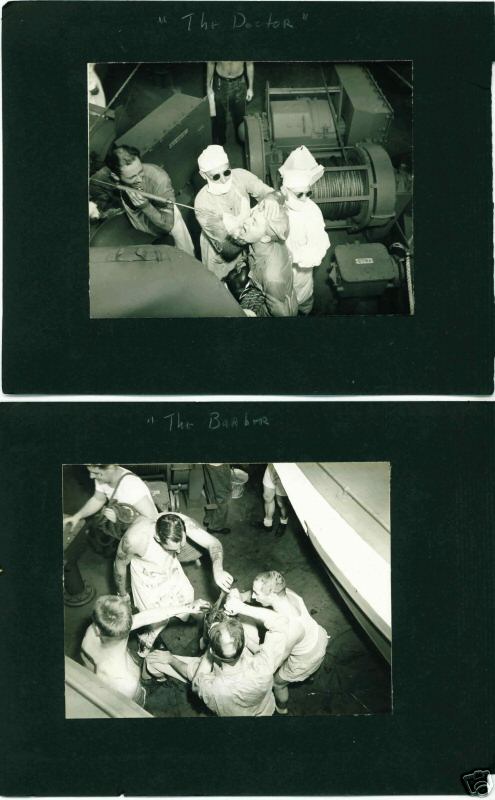
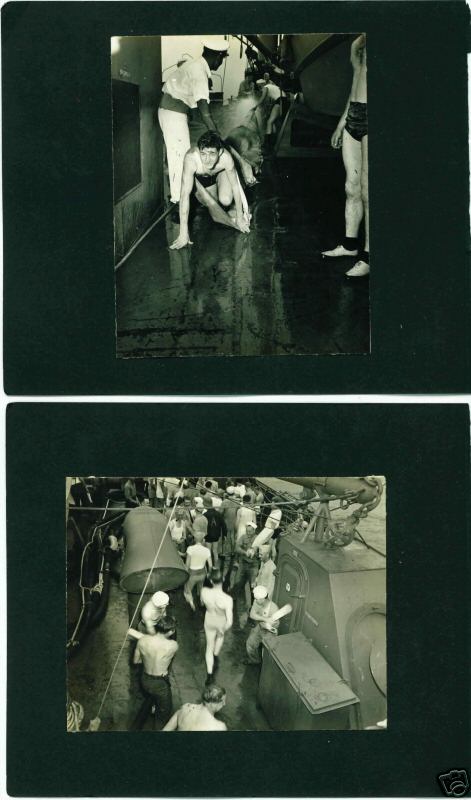
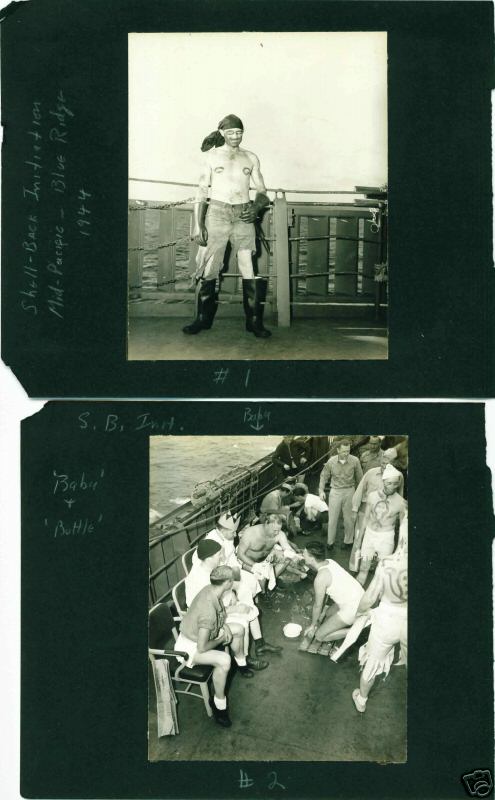
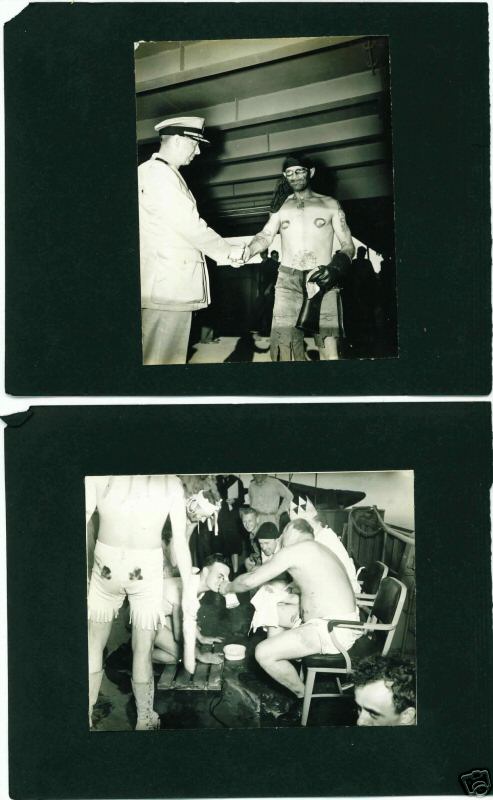
My hell.
thats the greatest generation.
My father Richard W Armil was the Aerographer's Mate on board the Blue Ridge. Does anyone remember him, have a piture of him, or able to offer any information? He passed away May 8, 2006 a very proud veteran.
|
- bill 7-09-2005 6:47 am
- bill 7-09-2005 6:47 am [add a comment]
sellers text :
i won this lot tonight for an uncontested $50.00- bill 7-09-2005 6:47 am [add a comment]
- bill 7-09-2005 7:44 am [add a comment]
- bill 7-09-2005 7:44 am [add a comment]
My hell.
- tom moody 7-09-2005 7:45 am [add a comment]
thats the greatest generation.
- bill 7-09-2005 8:09 am [add a comment]
My father Richard W Armil was the Aerographer's Mate on board the Blue Ridge. Does anyone remember him, have a piture of him, or able to offer any information? He passed away May 8, 2006 a very proud veteran.
- Tom Armil (guest) 5-11-2006 7:47 am [add a comment]